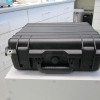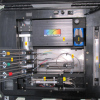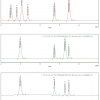Portable capillary liquid chromatograph
Technology description
| The name of the technology: | Portable capillary liquid chromatograph |
|---|---|
| Challenge: | Early detection and identification of mycotoxins and other undesirable substances, for example in food or water, is important to avoid adverse effects. For this purpose, several commercial applications of methods such as HPLC or ELISA have been developed in the past and are mainly used in laboratories. |
| Description: |
HPLC analysis of liquid samples is now possible in conditions outside the laboratory thanks to a miniaturized HPLC equipment. The design of the device is much simpler compared to standard HPLC and similar systems. It contains only one high pressure pump and only one valve. It uses the principles of dispersion of concentration interfaces to create mobile phase gradients as liquids flow through a suitable capillary. For the detection of substances separated on the capillary column, it uses a unique optical detector concept with the ability to simultaneously measure absorption at light wavelengths of 265 and 340 nm and fluorescence when excited by light at 365 and 470 nm. The detector includes LEDs as light sources, an original capillary detection cell and a CCD spectrometer. The selector valve and pump are automatically started after the analysis has been started. The detector signal is recorded for the duration of the analysis and can be processed in a chromatography integration program (e.g. Clarity) after the analysis is complete. Main benefits - Fast and accurate analysis in the field - Immediate monitoring of results - Eliminates sample transport logistics - Relatively low solvent consumption, low maintenance |
| Commercial opportunity: |
The device can be used by: - Private laboratories - Research and scientific centres - Hygienic stations - State administration bodies carrying out environmental monitoring |
| IP protection status: | |
| Development status: |
Phase 3Corresponds with TRL 5 and TRL 6 Technology validation and implementing it in real environment. Testing the technology outside of the laboratory and its adjustment to external conditions.
|
| Partnering strategy: | Collaboration licensing |
| More information: | The miniaturized liquid chromatograph was developed within the framework of the research, development and innovation project No. VI20172020069 "Development of modern instrumental methods for rapid detection and identification of selected B-agens and toxins". |
| Images: | |
| Categories: | Environment and Climate Research Tools Nanotechnology Research and development of food products Electrical Engineering |
| Owner of a technology: |



